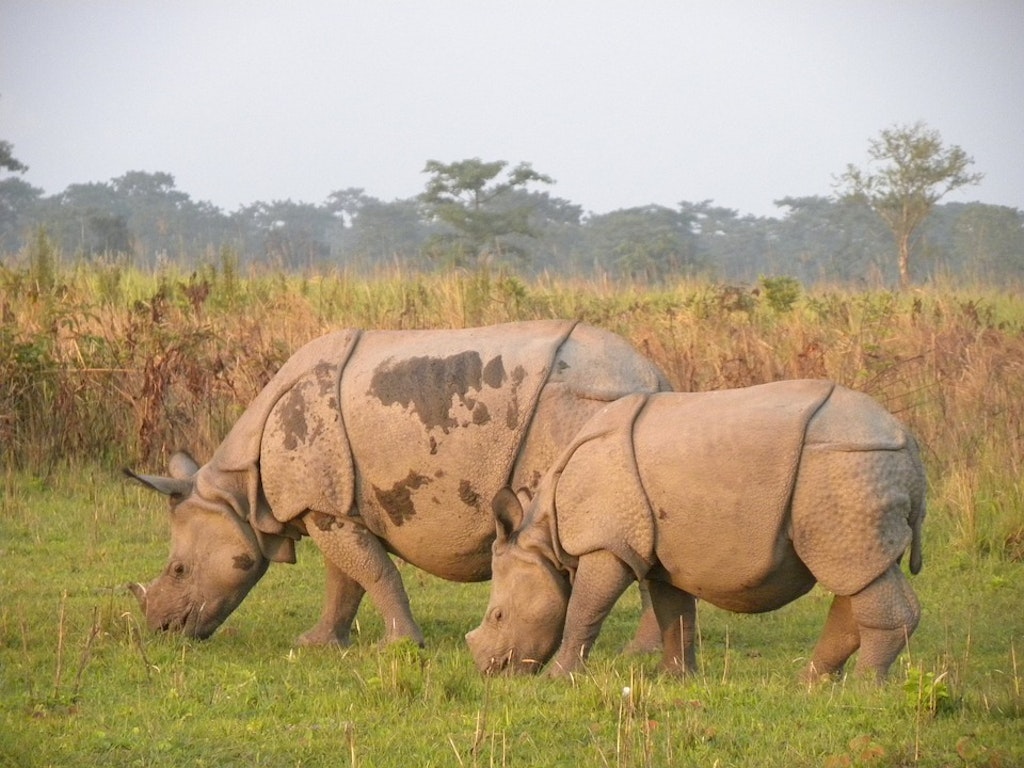Manas Tiger Reserve is situated at the foothills of the Himalayas in the state of Assam, India. This is surely one of a kind tiger reserve in the northeast. Manas is home to a good number of tigers. It also has many other species of animals like the one-horned rhinoceros, the pigmy hog, the hispid hare, the rare golden langur and another twenty more species of endangered animals and birds. The Manas Tiger Reserve was initially called as North Kamrup. This park is the greatest protected area in India in terms of the number of animals.
Timeline of Manas Tiger Reserve
- Listed as reserve forest – 1907
- Reinitiated as reserve forest – 1927
- Declared as a natural sanctuary – 1928
- Established as the core of Manas Tiger Reserve – 1973
- Added to World Heritage List – 1985
- Raised to National Park Status – 1990

Fun Facts
- Total Area – 360 sq km (gross area, 2840 sq km)
- Languages Spoken – Assamese, English
- Best Time to Visit Manas Tiger Reserve – October to April
- Address – Manas Road, Barangabari Gyati Village, Dist Baksa, Gobardhana, Assam 781315
When to Visit – Weather and other Information
The general climate of Manas is Tropical. During the monsoon season, the park receives very heavy rainfall. This has known to flood the park historically.
- During Summer – Avg 37-degree celsius
- During Winter – Avg 11-degree celsius
- Monsoon Season – May to September
Things to see in Manas Tiger Reserve
- Over 55 mammalian species
- 36 reptilian species
- 3 amphibian species
- Tiger Population – Over 80 in number
- Over 400 species of birds – including great pied hornbill, wreathed hornbill, waterfowls and Bengal Florican.
- Different species of monitor lizards and snakes.
- Assam Roofed Turtle
Other animals found in Manas tiger reserve include- Ganges dolphins, hog deer, Indian muntjacs, capped langurs, Hoolock gibbons, Assamese macaques, slow lorises, leopards, panthers, golden cat, fishing cat, marbled cat, binturongs, sloth bears, wild dogs, water buffaloes, gaurs (Indian bison), giant squirrels, hispid hare, otters, Indian pangolins, and some 2,000 elephants. You might be lucky to even spot the rare and charming red Panda at some higher grounds.

The tiger reserve is a nature lover’s paradise. With its rich biodiversity. you will be amazed to see a wide range of flora spread across the park. The northern parts of the forest have tropical semi-evergreen forests while the other regions are filled with tropical moist and dry deciduous forests.
The western grasslands are famous for its extensive grasslands filled with shrubbery and grasses. There is a large variety of aquatic flora in the Manas River.
Explore the national park by hiring a jeep. You can also choose to take the tours conducted by the Assam State Tourist Department. Visitors enjoy the boat trips and elephant rides that are convenient and also budget-friendly.
Places to visit around
- Wildlife Sanctuaries- Orang and Pabitora
- The religious town of Hajo
- Temple of Goddess Kamakhya
- Sarthebari village – Popular for its bell metalwork
- Barpeta town – Popular for the monastery and temple dedicated to Sankardeva
How to Reach Manas Tiger Reserve
- Nearest Airport – Guwahati – 176 Km – Around 6 hours by Road
- Nearest Railway Station – Barpeta – 136 Km from Guwahati
- You can also avail the bus services rendered by state transportation or private operators
We hope you are all set for your journey to visit this magnificent national park. Finding it difficult to go about booking? Worry not. You have come to the right place. Reach out to us at www.pickyourtrail.com for customised packages. You can also drop a Whatsapp inquiry to get the ball rolling on your vacation planning. So what are you waiting for?
Related Itineraries

Stunning 6 Nights Northern Lights Packages
- Flights excluded
- 4 star accommodations
- 3 activities
- Transfers excluded
₹ 64,954
Starting price/person

Fantastic 6 Nights Finland Northern Lights Tour Package
- Flights excluded
- 4 star accommodations
- 2 activities
- Shared transfer
₹ 69,369
Starting price/person

Beautiful 10 Nights Italy Honeymoon Package
- Flights included
- 4 star accommodations
- 9 activities
- Private transfer
₹ 1,32,869
Starting price/person

Ideal 6 day Switzerland Tour Packages for Family
- Flights included
- 3 star accommodations
- 3 activities
- Shared transfer
₹ 99,112
Starting price/person

Romantic 8 Nights Bali and Vietnam Honeymoon Packages
- Flights included
- 4 star accommodations
- 6 activities
- Shared transfer
₹ 99,947
Starting price/person

Gorgeous 9 Nights Singapore Bali Honeymoon Packages
- Flights excluded
- 4.5 star accommodations
- 6 activities
- Shared transfer
₹ 90,953
Starting price/person

Magical 9 Nights Germany Vacation Packages
- Flights excluded
- 4.5 star accommodations
- 8 activities
- Private transfer
₹ 79,832
Starting price/person

Scenic 10 Nights Greece & Turkey Vacation Packages
- Flights excluded
- 5 star accommodations
- 6 activities
- Shared transfer
₹ 60,718
Starting price/person

Magical 7 Nights Croatia Tour Packages
- Flights excluded
- 4 star accommodations
- 10 activities
- Shared transfer
₹ 57,778
Starting price/person

Beautiful 10 Nights Amsterdam Tour Package
- Flights excluded
- 4 star accommodations
- 8 activities
- Private transfer
₹ 1,84,115
Starting price/person



